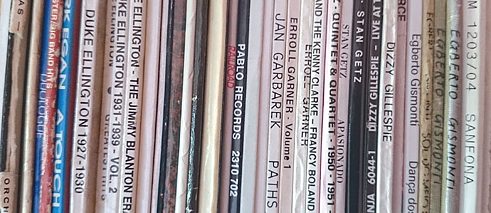Vinyl Records
A trend with downsides

Picture books celebrate record shops, events like the Record Store Week woo with vinyl, various music is again being pressed into black grooves. It is a trend with many facets, not all of which invariably tempt you to cheer.
Picture books celebrate record shops, events like the Record Store Week woo with vinyl, various music is again being pressed into black grooves. It is a trend with many facets, not all of which invariably tempt you to cheer.
What is there to the boom in records? A few facts and figures as a basis: at the end of 2015 the German Federal Music Industry Association (BVMI) decided to re-introduce the official Vinyl Charts; Great Britain preceded it a year earlier. According to BVMI statistics, 1.9 million vinyl albums were sold in Germany in 2015 (27 % more than in 2014), not including the numerous independent maxis. Overall, the German music market had a turnover of 1.55 billion euros (4.6 % more than 2014), of which 3.2 % was generated by vinyl.
Short runs yield numbers
It was only in 2012 that records began to recover. Their niche growth has various reasons: coolness, the sound, the desire to stand out from the mainstream, and the material and sentimental value of a record in contrast to an aseptic, cheap download; the retro trends of New Wave, Disco, Psychedelic, Krautrock and jazz did the rest. Limited editions, albums with cardboard CD inserts and download code made records again attractive. In particular, however, new or small labels began deliberately to decrease their vinyl production.Often they stopped at a run of 300 copies in order to increase the value, the demand and the hype for their releases. A new maxi, which was already sold out at the shops, often cost between 50 and 100 euros at the online portal Discogs. And because today every DJ who releases a record is at the same time his own producer, remixer, editor and label owner rolled up into one, and hence has no need of a big label and its advertising departments, there has been a striking increase in vinyl production in small editions.
Bottlenecks and asymmetric competition
This development, however, has more than one hitch. The total number of vinyl releases has currently reached the level of the 1990s, though in runs with a much lower number of units. But many manufacturers threw in the towel in the noughties. The few remaining larger pressing plants in Europe, such as Optimal Media GmbH, R.A.N.D. Muzik and Pallas in Germany, GZ in the Czech Republic, MPO in France and Record Industries in Holland, are at all events overstretched and today run off, using modern parallel press lines, twice or three times the amount daily.For smaller labels this can mean that they must wait up to six months for a test pressing and the final product – a catastrophe in the fast-paced music world of the present. In the era of streaming and accelerated promo hype machinery, this backlog in production is a problem, especially for club music genres like techno and house, which stood by vinyl at its low-point. Major labels are relying again increasingly on the old business, cramming international Record Store Days, online mail order portals, fashion chains and electronic markets full of reissues of old classics, straining the overloaded capacities of the remaining pressing plants and even going so far as buy into them so as occupy slots.
The trend towards the mainstream
Moreover, the boom now includes even the evergreens of music history. Young adults, who want to be modern and hip, buy old music new on records, and their children old discs or brand new disco maxis, but rare, overpriced ones, limited 300 issues. It is nice to see in the era of streaming that become community meeting points. It recalls an earlier time when small record shops were still lively social meeting points where you could talk about music with like-minded people. Especially gratifying is that the first bars and clubs are beginning to pay the vinyl DJ slightly more than the DJ who appears with a stick or laptop. Records have flair, the sound is deep, they go down well with the scene.A visit at the pressure plant Pallas in Diepholz / Germany, source: Aktiv Wirtschaftszeitung / Youtube
These are negative excesses, and there are also other ambivalences. If something appears on vinyl, it is relatively unlikely that, for example, undeclared samples will be noticed by the copyright holders. And when nearly every young artist today absolutely wants his work pressed into vinyl, this adds not only to the complexity of the market and the capacity overload of existing pressing plants, but also levels the special something about the medium that currently contributes to its popularity, quite apart from the tactile values, the covers, the placing on the record player or the limited editions. Perhaps the renaissance of vinyl will indeed mark the disappearance of the CD, and streaming will replace the MP3. The future is open.